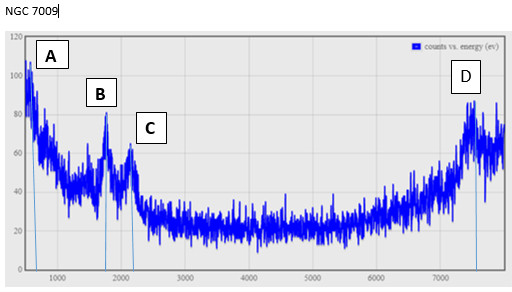The so-called Saturn Nebula emerges from the darkness as a series of irregularly shaped bubbles, illuminated in glorious shades of blue and pink. The Saturn Nebula was originally a low-mass star that expanded into a red giant at the end of its life and began to release matter from its outermost layers.
 Here you can find more information.
Here you can find more information.
This is the spectrum that I have studied:

Peak A obtains hydrogen
Peak B obtains scandium
Peak C obtains selenium
Peak D obtains europium
The total area it is of 56773850
Peak A area=3072603 so---------------------
Peak B area=3925248 so---------------------
Peak C area= 3383397------------------------
Peak D area= 7276026 so--------------------
The results are:
5.4% of hydrogen
6.91% of scandium
5.96% of Selenium
12.81% of europium
I've been investigating and I have found some interessant things.
First, in this article I discovered that in some nebulas (one of them NGC 7009) scientists have found Molecular Hydrogen Microstructures. That could be an explanation of the presence of H in my investigation.
On the other hand, here I read that the most important chemical elements are Oll, H, C and N. As I said before, I found H but I didn't find the rest of the elements.